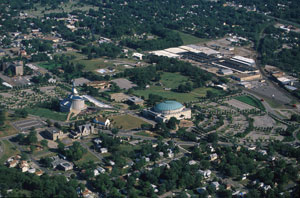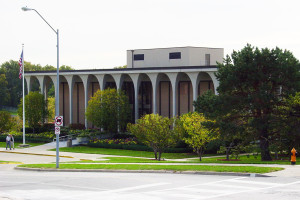Independence, Jackson County, Missouri, USA

Photo courtesy of Alexander L. Baugh
Independence, Missouri was designated as a gathering place for the Saints in a revelation given to Joseph Smith, Jr. in 1831.1 The same revelation also revealed that the Independence area was Zion and advised the area where a temple was to be built “lying westward, up a lot which is not far from the courthouse.”2
Shortly after becoming a member of The Church of Jesus Christ of Latter-day Saints, W. W. Phelps was directed to purchase a press and begin publishing a newspaper in Independence, Missouri. In June 1832, the first issue of The Evening and Morning Star was published. Additionally, the first compilation of the revelations revealed to Joseph Smith, the Book of Commandments, was published here.
The location for the temple was dedicated on “a spot lying westward” under the direction of Joseph Smith. John Whitmer described the events of the dedication as follows:
“Sidney Rigdon dedicated the ground where the city is to stand: and Joseph Smith, Jr. laid a stone at the Northeast corner of the contemplated Temple in the name of the Lord Jesus of Nazareth. After all present had rendered thanks to the great ruler of the universe, Sidney Rigdon pronounced this Spot of ground wholly dedicated unto the Lord forever: Amen.” 3
|
Key Events at Independence, Missouri
|
The site where the cornerstone was laid and dedicated is located near present day River Street and south of Lexington Avenue.4
In July 1833, a mob of 400-500 individuals gathered at the Independence courthouse to discuss the problem of the growing presence of the Mormons. The mob decided that the printing office should be destroyed and razed the building to the ground.4
The mob then captured Bishop Edward Partridge and Charles Allen, and dragged them to the public square where they gave as ultimatum: deny the Book of Mormon or leave Jackson County. They each refused either choice and were subsequently tarred and feathered. Bishop Partridge described the event as follows:
“Before tarring and feathering me I was permitted to speak. I told them that the Saints had suffered persecution in all ages of the world; that I had done nothing which ought to offend anyone; that if they abused me, they would abuse an innocent person; that I was willing to suffer for the sake of Christ; but, to leave the country, I was not then willing to consent to it…
I bore my abuse with so much resignation and meekness, that it appeared to astound the multitude, who permitted me to retire in silence, many looking very solemn, their sympathies having been touched as I thought; and as to myself, I was so filled with the Spirit and love of God, that I had no hatred towards my persecutors or anyone else.” 6
When the mob attacked the printing office, the Book of Commandments was being published. Two young girls, Mary Elizabeth and Caroline Rollins picked up as many sheets as they could of the unbound revelations and hid in a cornfield until the mob departed. They each subsequently received a copy of the Book of Commandments which they highly prized the rest of their lives.5
The mob returned the next day and forced the leaders of the Church to sign an agreement to leave Jackson County before April 1, 1834. The events that transpired here led to the Battle of the Big Blue and eventually Zion’s Camp. However, the Saints were never able to reclaim their land.
SOURCES
1 See Doctrine & Covenants 57:1.
2 Doctrine & Covenants 57:3.
3 John Whitmer, The Book of John Whitmer, [BYU, Harold B. Lee Library, L. Tom Perry Special Collections].
4 Arnold K. Garr and Clark V. Johnson, eds., Regional Studies in Latter-day Saint History: Missouri (Provo: Department of Church History and Doctrine, 1994), 289.
5 Joseph Smith, History of The Church of Jesus Christ of Latter-day Saints, 7 vols., introduction and notes by B. H. Roberts (Salt Lake City: The Church of Jesus Christ of Latter-day Saints, 1932-1951), 1: 391.
6 Our Heritage: A Brief History of The Church of Jesus Christ of Latter-day Saints, (Salt Lake City: The Church of Jesus Christ of Latter-day Saints, 1996), 41.
Map & Directions
Ownership Status
The LDS Visitors’ Center at Independence, MO is a Church Historic Site, owned and operated by The Church of Jesus Christ of Latter-day Saints. Visitors are welcome during posted hours. Admission is free.
Photos

Articles & Resources
Bishop Edward Partridge's Account of Being Tarred and Feathered
Author(s): Edward Partridge
Type: First-person account
Source(s): Joseph Smith, History of The Church of Jesus Christ of Latter-day Saints, 7 vols., introduction and notes by B. H. Roberts (Salt Lake City: The Church of Jesus Christ of Latter-day Saints, 1932-1951), 1: 390-391.
I was taken from my house by the mob, George Simpson being their leader, who escorted me about half a mile, to the court house, on the public square in Independence; and then and there, a few rods from said court house, surrounded by hundreds of the mob, I was stripped of my hat, coat and…
The History of Jackson County, Missouri, 1881.
Richard L. Anderson, “Jackson County in Early Mormon Descriptions,” Missouri Historical Review, 1971.
Lamar C. Berrett, “Independence, Missouri,” Encyclopedia of Mormonism, ed. Daniel H. Ludlow et al., 1992.
Julius C. Billeter, The Temple of Promise: Jackson County, Missouri, 1946.
R. T. Bray, “The Evening and Morning Star,” Restoration Trail Forum, 1977.
R. J. Britton, “Mormon Land Titles: A Story of Jackson County Real Estate,” Missouri Valley Historical Society Publication, 1922.
Alma P. Burton, Toward the New Jerusalem, 1985.
James G. Duffin, “Retribution-Order No. 11,” Improvement Era, September 1905.
Alvin R. Dyer, “The Foundation in the Center Place of Zion,” Annual Joseph Smith Memorial Sermon, 1968.
Alvin R. Dyer, Refiner’s Fire: Historical Highlights of Missouri, 1968.
Kenneth W. Godfrey, “New Light on Old Difficulties: The Historical Importance of the Missouri Affidavits,” Regional Studies in Latter-day Saint Church History: Missouri, ed. Arnold K. Garr and C. V. Johnson, 1994.
Warren A. Jennings, “The Army of Israel Marches into Missouri,” Missouri Historical Review, 1968.
Warren A. Jennings, “The City in the Garden: Social Conflict in Jackson County, Missouri,” The Restoration Movement: Essays in Mormon History, ed. F. M. McKiernan et al., 1973.
Warren A. Jennings, “The Expulsion of the Mormons from Jackson County Missouri,” Missouri Historical Review, 1969.
Warren A. Jennings, “Factors in the Destruction of the Mormon Press is Missouri, 1833,” Utah Historical Quarterly, 1967.
Warren A. Jennings, “Importuning for Redress,” Bulletin of the Missouri Historical Society, 1970.
Warren A. Jennings, “Isaac McCoy and the Mormons,” Missouri Historical Review, 1966.
Warren A. Jennings, “Zion is Fled: The Expulsion of the Mormons from Jackson County, Missouri,” 1962.
Andrew Jenson, “Jackson County, Missouri,” Historical Record, 1888.
Clark V. Johnson, “The Law of Consecration: The Covenant That Requires All and Gives Everything,” Doctrines for Exaltation: The 1989 Sperry Symposium on the Doctrine and Covenants, ed. H. Dean Garrett and R. C. Reeve, Jr., 1989.
Clark V. Johnson, “Missouri: LDS Communities in Jackson and Clay Counties,” ed. Daniel H. Ludlow et al., 1992.
Eleanor M. Johnson, “The Gathering of the Mormons in Jackson County, Missouri,” 1927.
Roger D. Launius, “A Question of Honor? A. W. Doniphan and the Mormon Expulsion from Jackson County,”  Nauvoo Journal, Fall 1998.
Nauvoo Journal, Fall 1998.
T. Edgar Lyon, “Independence, Missouri, and the Mormons, 1827-1833,”  BYU Studies, 1972.
BYU Studies, 1972.
Max H. Parkin, “The Courthouse Mentioned in the Revelation on Zion,”  BYU Studies, 1974.
BYU Studies, 1974.
Max H. Parkin, “Independence, Missouri,” Historical Atlas of Mormonism, ed. S. K. Brown et al., 1994.
Larry C. Porter, “The Colesville Branch in Kaw Township, Jackson County, Missouri,” Regional Studies in Latter-day Saint Church History: Missouri, ed. Arnold K. Garr and C. V. Johnson, 1994.
M. H. Siegfried, “The Exodus from Jackson County,” Journal of History, 1912.
H. C. Smith, “Causes of the Trouble in Jackson County, Missouri, in 1833,” Journal of History, 1909.
H. C. Smith, “Independence in an Early Day,” Journal of History, 1912.
Bruce A. Van Orden, “Causes and Consequences: Conflict in Jackson County,” Regional Studies in Latter-day Saint Church History: Missouri, ed. Arnold K. Garr and C. V. Johnson, 1994.
W. L. Webb, “The Mormons,” The Centennial History of Independence, Mo., 1927.
Elias S. Woodruff, “‘Zion’ As It Is Today,” Improvement Era, October 1937.
